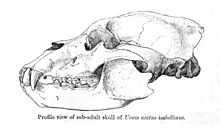Himalayan brown bear
| Himalayan Brown Bear | |
|---|---|
.jpg) | |
| Himalayan Brown Bear in Perm Zoo, Russia | |
| Conservation status | |
| Scientific classification | |
| Kingdom: | Animalia |
| Phylum: | Chordata |
| Class: | Mammalia |
| Order: | Carnivora |
| Family: | Ursidae |
| Genus: | Ursus |
| Species: | U. arctos |
| Subspecies: | U. a. isabellinus |
| Trinomial name | |
| Ursus arctos isabellinus Horsfield, 1826 | |
The Himalayan Brown Bear (Ursus arctos isabellinus), also known as the Himalayan Red Bear, Isabelline Bear or Dzu-Teh, is a subspecies of the Brown Bear. The bear (as the Dzu-Teh) is thought to be the source of the legend of the Yeti.[1][2]
Description
Himalayan Brown Bears exhibit sexual dimorphism. Males range from 1.5m up to 2.2m (4 ft 11in - 7 ft 3in) long, while females are 1.37m to 1.83m (4 ft 6 in - 6 ft) long. They are the largest animals in the Himalayas and are usually sandy or reddish-brown in colour.
Distribution
The bears are found in Nepal, India, Pakistan and Tibet. They are already speculated to have become extinct in Bhutan.
Behaviour and ecology
The bears go into hibernation around October and emerge during April and May. Hibernation usually occurs in a den or cave made by the bear.
Feeding
Himalayan Brown Bears are omnivores and will eat grasses, roots and other plants as well as insects and small mammals they also like fruits and berries. They will also prey on large mammals, including sheep and goats. Adults will eat before sunrise and later during the afternoon.
Status and conservation
International trade is prohibited by the Wildlife Protection Act in Pakistan. Snow Leopard Foundation (SLF) in Pakistan conducts research on the current status of Himalayan brown bears in the Pamir Range in Gilgit-Baltistan, a promising habitat for the bears and a wildlife corridor connecting bear populations in Pakistan to central Asia. The project also intends to investigate the conflicts humans have with the bears, while promoting tolerance for bears in the region through environmental education. SLF received funding from the Prince Bernhard Nature Fund and Alertis. [3]
The Himalayan brown bear is a critically endangered species in some of its range with a population of only 150-200 in Pakistan. The populations in Pakistan are slow reproducing, small, and declining because of habitat loss, fragmentation, poaching, and bear baiting.[3]
Association with the Yeti

"Dzu-Teh", a Nepalese term, has also been associated with the myth of the Yeti, or 'Abominable Snowman', with which it has been sometimes confused or mistaken. During the Daily Mail Abominable Snowman Expedition of 1954, Tom Stobbart encountered a "Dzu-Teh". This is recounted by Ralf Izzard, the Daily Mail correspondent on the expedition, in his book The Abominable Snowman Adventure.[4] The report was also printed in the Daily Mail expedition dispatches on May 7, 1954 .
There is no real reason to associate Stobbart's information with the term "Dzu-Teh", however, and the use of the term by him, a non-native, can only have been presumptive.
Notes
- ↑ The Japan Times, 18 September 2003.
- ↑ BBC News — Yeti's 'non-existence' hard to bear
- ↑ 3.0 3.1 "Alertis Secures Grant". http://www.alertis.nl/. Retrieved 18 July 2013.
- ↑ Ralph Izzard. (1955). "The Abominable Snowman Adventure". Hodder and Staoughton. "no"
References and further reading
- "Status and Affinities of the Bears of Northeastern Asia", by Ernst Schwarz Journal of Mammalogy 1940 American Society of Mammalogists.
- Ogonev, S.I. 1932, "The mammals of eastern Europe and northern Asia", vol. 2, pp. 11–118. Moscow.
- Pocock R.I, "The Black and Brown Bears of Europe and Asia" Part 1. Journal or Bombay Natural History Society., vol. 35, no. 4, pp. 772–823, figs 1-11. July 15, 1932.
- Ursus arctos, by Maria Pasitschniak, Published 23 April 1993 by "The American Society of Mammalogists"
- John A. Jackson, "More than Mountains", Chapter 10 (pp 92) & 11, "Prelude to the Snowman Expedition & The Snowman Expedition", George Harrap & Co, 1954
- Ralph Izzard, "The Abominable Snowman Adventure", this is the detailed account by the Daily Mail correspondent on the 1954 expedition to find the "Snowman", Hodder and Staoughton, 1955.
- Charles Stonor, "The Sherpa and the Snowman", recounts the 1955 Daily Mail "Abominable Snowman Expedition" by the scientific officer of the expedition, this is a very detailed analysis of not just the "Snowman" but the flora and fauna of the Himalaya and its people. Hollis and Carter, 1955.
- John A. Jackson, "Adventure Travels in the Himalaya" Chapter 17, "Everest and the Elusive Snowman", 1954 updated material, Indus Publishing Company, 2005.
- Bear species found in India
| Wikispecies has information related to: Ursus arctos |
External links
- Video of Himalayan brown bear and a Tibetan fox on the hunt from PBS Video
- Brown Bear Conservation Project of HWF
- Prof. Dr W. Henke, Mainz Institute of Anhtropology, Original German Version
- Himalayan Red Bear
- Red Bear
- Cryptozoology
- The Yeti
- Daily Mail Abominable Snowman
